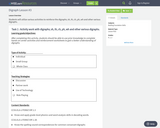
Students will utilize various activities to reinforce the digraphs; sh, th, ch, ph, wh and other various digraphs.
- Subject:
- Reading Foundation Skills
- Material Type:
- Lesson Plan
- Author:
- Elizabeth Wanetan
- Date Added:
- 05/31/2018


Students will utilize various activities to reinforce the digraphs; sh, th, ch, ph, wh and other various digraphs.
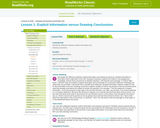
This resource provides a 50 minute lesson plan for teaching the difference between explicit information and drawing conclusions. The lesson provides materials for guided and independent practice on the website as well as a leveled book list.

ESGI is a huge time saver for assessment! The website has over 200 pre-built assessment for all early learning benchmarks. Save time and trees- go digital! The company offers a 60 day free trial. No committment to get started.
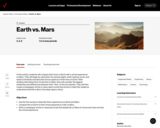
In this activity, students will compare their lives on Earth with a virtual experience on Mars. They will begin by using their five senses (sight, smell, hearing, touch, and taste) to illustrate and describe various aspects of their lives on Earth. After similarly describing their virtual time on Mars, they will consider the biggest similarities and differences between their “time” on the two planets. They will then create a newspaper article or news report script that strives to help their audience understand what life is like in this deep-space colony.
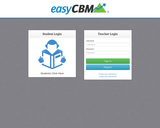
"The easyCBM system was developed by educational researchers at the University of Oregon in close collaboration with school district partners across the United States. It is designed to give teachers insight into which of their students may need additional instructional supports as well as to provide a means by which they can measure the effectiveness of their teaching. System reports provide information that supports evidence-based decision making, and the Interventions interface streamlines the process of keeping track of students' instructional program, a feature that is particularly helpful for student study team meetings and parent conferences.
The full District system includes a variety of curriculum based measures in the content areas of early literacy in both English and Spanish as well as oral reading fluency, vocabulary, and reading comprehension. In addition, it offers mathematics measures with reach to both the National Council of Teachers of Mathematics (NCTM) Focal Point Standards and the Common Core State Standards in Mathematics, with built-in read-aloud and Spanish translation accommodations. The Teacher Deluxe Edition offers the same features as the District version, but is optimized for individual teacher, rather than system-wide adoption. A truncated version, the Lite Edition, is available free of charge for individual teachers."

The words this strong and determined pioneer put to paper about her life in what would become Wisconsin opened a window into the past.
Resources available for exploring this story include:
- A short animated video with captions and transcripts in English and Spanish
- A short biography book accessible as a slide deck, with per-page audio for listening along, and maps of key locations in the story
- Questions that can be used for conversation, reflection, and connection with the story
- A historical image gallery full of primary and secondary sources to explore
- A guide for activating the media with learners that includes story stats, extension activity ideas, and standards supported
This story is part of Wisconsin Biographies, a collection of educational media resources for grades 3-6. Explore the full collection at pbswisconsineducation.org/biographies.
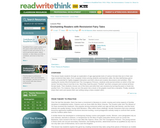
Students look at ways to compare fairy tales as a genre. The lessons use Ella Enchanted and The Courageous Princess as a framework for journal writing and reflection from a first-person perspective. The poem "Grethel" is the next literature piece used for comparison of heroines. After analyzing the various texts, students create their own revision using a different format (poem or graphic novel). The series of 4 lessons include a step-by-step instructional plan, printouts which include:
Common elements of a fairy taleSituations for fairy talesComic book primerAdditional website links
Students share out their works and assess their writing with a class-created rubric.
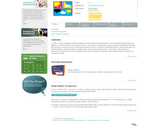
In order to fully comprehend reading materials, students need to understand the cause-and-effect relationships that appear in a variety of fiction and nonfiction texts. In this lesson, students learn cause-and-effect relationships through the sharing of a variety of Laura Joffe Numeroff picture books in a Reader's Workshop format. Using online tools or a printed template, students create an original comic strip via the writing prompt, "If you take a (third) grader to." Students use various kinds of art to illustrate their strip and publish and present their completed piece to peers in a read-aloud format.

The article presents a lesson plan for teaching the use of figurative language with homophones, puns, and homonyms through activities such as book reading, creating illustrated pages for a poster display or class book, and writing or acting out riddles or skits using homophones and homonyms.
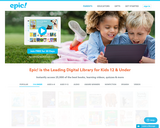
Epic! is a website that gives access to over 20,000 books for kids 12 and under, including audio and read to me books.
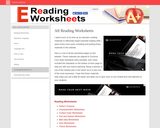
This resource offers ELA teachers over 100 exercises to teach a variety of Common Core lessons. The following are included: reading comprehesion, figurative language, genre, grammar, punctuation, sentence structure, point of view, text structure, and writing. The exercises have standards attached, and often there is a power point to present the lesson. It is also organized by grade level, making use for teachers extremely efficient.
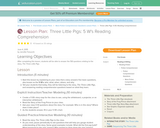
Using the tale of the Frog Prince and the 3 little pigs students will be able to write sentences using the 5 W's, Who?, What?, When?, Where?, Why?.
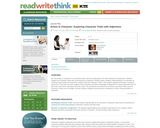
Students become the character through a series of activities in this lesson plan. The plans cover 3-50 minute lessons. The lesson scaffolds through steps from listing personal character traits into character analysis of a popular example from Harry Potter and the Sorcerer's Stone. Graphic organizers and charts connect adjectives to character traits, Lists of character traits are included in the lesson as a beginning framework. An interactive piece is included on the link, allowing students to create their own character charts. A final activity involves students guessing each other based on their use of "strong adjective" descriptions. All handouts and graphic organizers are readily available on the website.
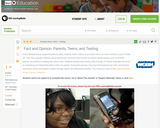
This lesson requires student to evaluate various types of texts including video, visuals, etc. and to communicate their learning in multiple ways (discussions and writing). Large emphasis on utlizing mutliple reading strategies.

Do worms live underground? Are they good diggers? Can they really read and write? As students read Doreen Cronin's Diary of a Worm in this lesson, they learn to separate the facts from the fictional details. Students begin the lesson by brainstorming what they know about worms. They then begin examining the book in layers. Four read-aloud sessions engage students by focusing attention on different features of the text in each session. In a whole-group setting, students explore the illustrations, fictional details, nonfiction details, and captions and speech bubbles. In this way, students are given concrete strategies that they can use to help differentiate narrative and informational elements in other books they read.
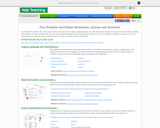
This powerpoint is an introduction to the use of figurative language. It uses definitions and visual examples to assist students with the various types of figurative language. There is a quiz at the end of the slide show to assess student learning/understanding of figurative language.
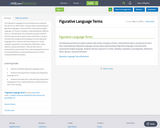
The Figurative Language Terms worksheet was created for the CESA #1 EL OER Project. Having a deep understanding of figurative language is essential while acquiring the English language. For many EL students, understanding the different terms is overwhelming. This worksheet provides students with the opportunity to watch videos and listen to songs to increase their background knowledge of various figurative language terms. Students will have exposure to: simile, metaphor, hyperbole, onomatopoeia, alliteration, idiom, allusion, and personification. They will also have an opportunity to demonstrate their understanding of the terms by writing definitions, drawing labeled pictures, and/or creating individual examples.
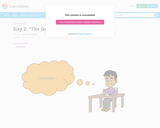
This lesson teaches students to understand figurative language and how it effects meaning. The students will read a nonfiction piece on The Great Chicago Fire. Students can then work with a partner or small group to answer the questions about the figurative language.
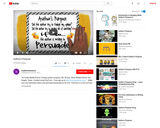
In this lesson, students will get an introduction on how to identify author's pupose (persuade, inform, or entertain). Students will also learn how to recognize author's purpose by asking questions.
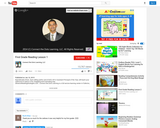
This first grade reading video lesson models how to separate the individual sounds in phonetically sound words. The instructor also reviews certain sight words for students to practice reading.